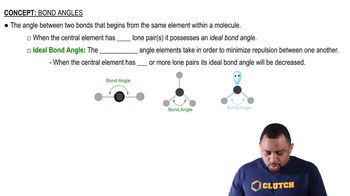Ethyl acetate, C4H8O2, is a fragrant substance used both as a solvent and as an aroma enhancer. Its Lewis structure is
(e) How many valence electrons remain in nonbonding pairs in the molecule?
 Verified step by step guidance
Verified step by step guidance



Ethyl acetate, C4H8O2, is a fragrant substance used both as a solvent and as an aroma enhancer. Its Lewis structure is
(e) How many valence electrons remain in nonbonding pairs in the molecule?
Consider the Lewis structure for acetic acid, which is known as vinegar:
(a) What are the approximate bond angles about each of the two carbon atoms, and what are the hybridizations of the orbitals on each of them?
Consider the Lewis structure for glycine, the simplest amino acid:
(b) What are the hybridizations of the orbitals on the two oxygens and the nitrogen atom, and what are the approximate bond angles at the nitrogen?
Consider the Lewis structure for glycine, the simplest amino acid:
(c) What is the total number of s bonds in the entire molecule, and what is the total number of p bonds?
(a) Write a single Lewis structure for N2O, and determine the hybridization of the central N atom.